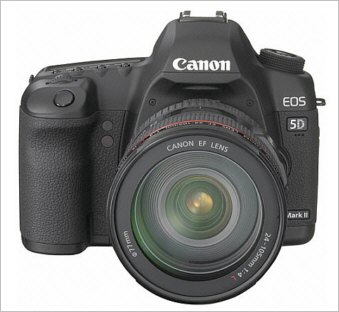

Canon EOS 5D Mark II - Full "hands on" Review
 The new Canon EOS 5D MkII |
You can check the current
|
The new Canon EOS 5D MkII is something of a hybrid between the Canon EOS 50D and the Canon EOS 1Ds MkIII, in fact Canon in one of their publications say that the EOS 5D MkII "...shares 80% of its features with the EOS 5D, and 10% with the flagship Canon EOS-1Ds Mark III...". The Canon EOS 5D MkII has most of the firmware features of the 15MP crop sensor 50D, but uses a full frame 21.1MP sensor, similar (but not identical) to that in the EOS 1Ds MkIII. In addition, the EOS 5D MkII has a few unique tricks of its own, such as 30fps, 1920 x 1080 HD video with sound! It shares a basic body design and control layout with the original 12.8 MP EOS 5D, and of course both have a 24mm x 36mm full frame sensor.
Here are the main differences between the original Canon EOS 5D and the new Canon EOS 5D MkII:
| New Canon EOS 5D Mark II | Original Canon EOS 5D |
| 21.1 MP CMOS sensor with improved microlens design | 12.9 MP CMOS sensor |
| 920,000 pixel, 3" high resolution LCD | 230,000 pixel, 2.5" |
| shutter rated to 150,000 shots | shutter rated to 100,000 shots |
| Startup time ~0.1s | Startup time ~0.2s |
| 14 bits per color A/D conversion | 12 bits per color A/D conversion |
| 0.76x viewfinder magnification, approx. 21mm eyepoint, 98% coverage | 0.71x viewfinder magnification. 20mm eyepoint, 96% coverage |
| Viewfinder data includes ISO speed, Highlight Tone Priority indicator (D+), monochrome: B/W, and Battery check indicator | ISO displayed only when changing setting. No battery, HTP or monochome indicators. |
| Upgraded moisture and dust seals around battery compartment, memory card compartment and multiple buttons | Standard dust and moisure sealing |
| Microfocus adjustment on a fixed or lens by lens basis | No microfocus adjustment |
| Improved long exposure noise reduction, and high ISO noise reduction with four settings available in camera | High ISO noise reduction only available in DPP |
| Highlight Tone Priority | No Highlight Tone Priority |
| 4 levels of auto lighting optimization | No Auto Lighting Optimizer |
| An ISO range from 100-6400, plus 50 (L) 12800 (H1) and 25600(H2) | ISO range 100-1600 plus 50 (L) and 3200 (H) |
| Auto ISO range 100-1600 | No auto ISO |
| Contrast detection AF in Live View mode | No Live View |
| Face detection in Live View mode | No Live View |
| Recording and playback of 1080p Full HD video (1920 x 1080 pixels per frame at 30 fps) with sound in Live View mode | No Video |
| Built-in microphone records in mono; 3.5mm diameter stereo mini jack can be used to record from external source | No sound recording |
| Continuous HD movie recording time up to approximately 12 minutes using a 4GB CF card | No Video recording |
| 3.9 fps continuous shooting with bursts limited only by memory card capacity ( JPEG, Large/Fine images in high-speed continuous mode) when using a UDMA CF card or up to 14 in RAW, up to 13 in RAW+JPEG Large/Fine | 3 fps continuous shooting 60 JPEG/17 RAW |
| In camera illumination (vignetting) correction for JPEGs | Only available in DPP for RAW files |
| A "creative auto" mode | None |
| "C1", "C2" and "C3" custom modes | One custom mode ("C") |
| HDMI output | None |
| A Digic IV processor | A Digic II processor |
| Faster USB data transfer | USB 2.0 |
| Compatible with RC-1 Infrared remote control | No IR remote compatibiliy |
| Support for high speed UDMA-compliant CF cards | No UDMA support |
| Improved EOS Integrated Sensor Cleaning System | No sensor cleaning system |
| New higher capacity intelligent lithium-ion battery (1800mAh) | Standard BP511/512 battery |
As you can see, there are a number of new features. The most significant in my opinion are the sensor upgrade from 12.8 to 21.1MP, the addition of an integrated sensor cleaning system, the addition of Live View and the ability to shoot broadcast quality HD video with stereo sound, compatibility with the inexpensive RC-1 and RC-5 infrared remote control units, the expanded ISO range (50-26500) and the provision of AF microadjustment.
NEXT: Operating Controls
